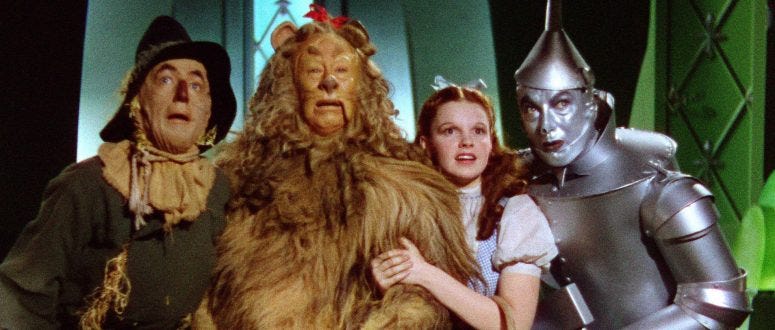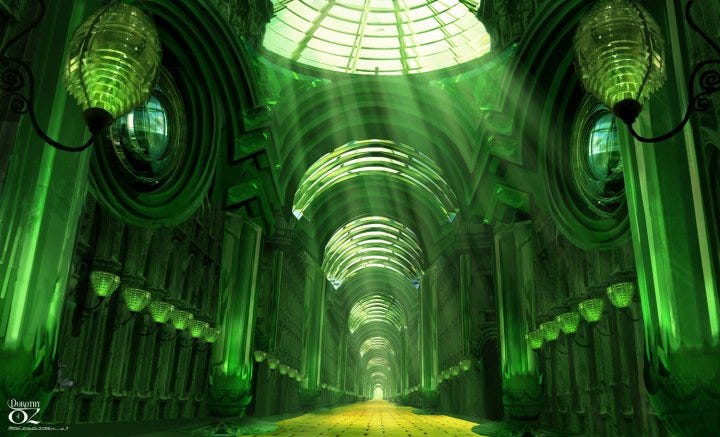The Wizard of Oz & The Quest for Freedom From Dogma
An excerpt from Interference by Richard Merrick
The monumental struggle between the Church and paganism has been told many times, in many ways. But of all the stories, none has resonated with people more than the 1939 film The Wizard of Oz starring Judy Garland.
Based on the book The Wonderful Wizard of Oz by L. Frank Baum, this film is usually thought of as a nice American fairy tale or perhaps a thinly veiled political commentary, as suggested by Henry M. Littlefield in his “Parable on Populism”. But it is more likely a tale of the Roman Catholic Church’s war against paganism and the freedom to pursue truth in nature.
It all begins on the Kansas prairie, a symbol for the colorless material world, with a girl named Dorothy Gale.24 After singing Somewhere Over the Rainbow, in which she wishes upon a star, our heroine is swept up by a spiraling tornado and deposited in a colorful and musical place called Munchkinland. Populated by a cherub-like pagan tribe called Munchkins25, their leader the good witch Glenda presents magical ruby-crystal slippers to Dorothy.
She is then told to follow the yellow brick road (a continued golden spiral from the twister) to reach the great wizard of Oz who has the power to send her home. Taken from the Hebrew name meaning “strength,” Oz represents enlightenment in the “inmost chamber” of Dorothy’s mind.
As she walks in fear along the golden path, traveling through a dark forest symbolizing nature, she meets three wise men – the Scarecrow, the Tin Woodsman and the Cowardly Lion. As personifications of Dorothy’s fear, the mindless Scarecrow represents her loss of reason and direction, the rusty Tin Woodsman her loss of heart and spirit, and the Cowardly Lion (the Egyptian sphinx) represents her loss of courage and confidence.
At the end of her journey, just before she is about to fall asleep under an evil spell, Dorothy arrives at the legendary Emerald City of Oz – symbolic of the Emerald Tablet of Egyptian philosopher Hermes Trismegistus.
Gaining entry to the city, Dorothy asks to see the “great and powerful Oz” to ask for his help in returning home. When she meets the wizard, appearing as a terrifying personification of the medieval Inquisition, he is the gatekeeper to knowledge and demands that she dispose of his adversary, the Wicked Witch of the West, to learn how to return home.
As the wizard’s crusader against paganism, Dorothy journeys to the witch’s lair and sneaks into her watchtower, but is discovered and captured. Fortunately, Dorothy manages to escape and ultimately slays the pagan witch through holy baptism.
Having conquered paganism, Dorothy returns triumphantly to the wizard and again pleads with him to take her home. But instead of honoring his promise, the fiery wizard orders her away. Angry at the wizard’s broken promise, Dorothy’s dog Toto (representing her inner spirit and intuition) pulls back a velvet curtain (symbolizing the façade of Church doctrine) to reveal the fact that the powerful wizard is no great deity after all – just a man.
Now enlightened and full of inner strength, Dorothy takes back her reason, her intrinsic spirituality and her courage along with a promise from the would-be wizard (whose real name is Oscar Zoroaster26) to take her home. But as the former carnival wizard (now representing modern science) is about to spirit her away in a balloon (symbolizing technology), an error occurs and he only saves himself, leaving Dorothy to find her own way home.
While it would seem that Dorothy had lost her last chance to find salvation, the good witch Glenda (meaning “holy and good”) suddenly reappears in a sphere to tell her she can return any time she wants through the power of 3 in her own mind. With this, Dorothy realizes that salvation is not found in the promises of either religion or science, but only in the inmost chamber of her own mind. As she wakes up from her inner Underworld adventure, we too wake up to the black and white reality that nature’s harmony has remained hidden from Western society far too long.27
We now know with some certainty the cast of characters who worked so hard behind the velvet curtain to conceal the truth about the tritone and its relationship to nature. It started with Boethius, then Alcuin of York, Aurelian of Reome, Guido of Arezzo, Gerbert of Aurillac, Odo of Clunym, Isidore of Seville, Hermannus Contractus, Johannes Cotto, Franco of Cologne, monk Gratian and ultimately Pope Gregory IX. Each of these people, all in good faith of course, played critical roles in establishing the tritone’s unfortunate reputation in music history and scarce mention in music theory.
We also know how and when the tritone was outlawed. Rules of omission began to take shape during the rise of Catharism in the 11th century with Guido of Arezzo. They were then systemized by monk Gratian and further codified in the late 11th and early 12th century by both Johannes Cotto and Franco of Cologne. In 1234, Pope Gregory IX then promulgated this musical doctrine into canon law as a philosophical cornerstone of the Catholic Inquisition, requiring every Roman Catholic Church to honor its policy of tritone avoidance.
Yet even as these tritone omission laws became increasingly entrenched into the late Renaissance, a rebellion was brewing against this and other papal laws. Leading the charge was, of course, German monk and theologian Martin Luther.
The Inquisition and Crusades never ended.








